
95% of researchers rate our articles as excellent or good
Learn more about the work of our research integrity team to safeguard the quality of each article we publish.
Find out more
ORIGINAL RESEARCH article
Front. Phys. , 15 July 2024
Sec. Interdisciplinary Physics
Volume 12 - 2024 | https://doi.org/10.3389/fphy.2024.1420874
This article is part of the Research Topic Wave Propagation in Complex Environments View all 13 articles
The use of boundary elements in two-dimensional acoustic analysis is presented in this study, along with a detailed explanation of how to derive the final discrete equations from the fundamental fluctuation equations. In order to overcome the fictitious eigenfrequency problem that might arise during the examination of the external sound field, this work employs the Burton-Miller approach. Additionally, this work uses the Taylor expansion to extract the frequency-dependent component from the BEM function, which speeds up the computation and removes the frequency dependency of the system coefficient matrix. The effect of the radiated acoustic field generated by underwater structures’ on thin-walled structures such as submarines and ships is inspected in this work. Numerical examples verify the accuracy of the proposed method and the efficiency improvement.
Water, as another common acoustic medium, has a much higher acoustic impedance than air, and the difference between it and the mechanical impedance of common structures is not so large as to be directly negligible. Therefore, the effect of the radiated acoustic field generated by the vibration of underwater structures on structures in general and on thin-walled structures such as submarines and ships in particular is usually difficult to be directly ignored. These structures are subject to significant vibration during underwater navigation. Structural vibration causes noise [1–5], which in turn affects [6] the surrounding environment, thus triggering the engineering requirements for noise reduction. The analysis of the noise problem is actually the acoustic analysis [7, 8]. In the past research, the acoustic problems are divided into the finite sound field problems (also called the internal sound field problems) [9–12] and the infinite sound field problems (also called the external sound field problems) [13–15]. For finite sound field or internal sound field problems, the finite element method (FEM) [16–18] has been effective in solving such problems and has been widely used in practical analysis. The analysis of the outer sound field problem is much more complex than the inner sound field, and the analysis of the infinite sound field [19, 20] leads to a drastic increase in the computational volume, which is difficult to bear. The boundary element method (BEM) [21–26], on the other hand, only needing to discretize the model on the boundary, while automatically satisfying the radiation conditions at infinity, is widely used in the analysis of external acoustic problems [27, 28]. Moreover, BEM is a semi-analytic method constructed on the basis of the basic solution, leading to a higher accuracy.
Although BEM has many advantages in acoustic analysis, it also has some drawbacks. The first one is the singularity problem, which leads to poor accuracy or even wrong results. Chen et al. [29–32] successfully applied the singular phase elimination technique to the discontinuous higher-order element and compared the accuracy performance of different elements. The second one is the fictitious eigenfrequency problem [33–36], and the main solutions to this problem are CHIEF method and Burton-Miller method [37–40]. In this paper, Burton-Miller is used to solve the fictitious eigenfrequency problem. The third one is the high memory requirement problem. The coefficient matrix formed using BEM [41–43] is a dense matrix with high memory requirement, which limits the application of BEM in large-scale problems. However, although the boundary element coefficient matrix is dense, it has the property of low rank. A series of fast methods [44–46] using low-rank decomposition have been proposed, including fast multipole method, H-matrix, adaptive cross approximation and some other fast algorithms, which could successfully reduce the computational volume and memory usage, making it possible to apply BEM on complex engineering problems [47–49]. The fourth one is the frequency dependent problem. Unlike FEM, the kernel function of BEM is frequency-dependent. The discrete formation of the coefficient matrix is influenced by frequency, necessitating its recalculation under each distinct frequency [50–52], leading to a sharp increase in the computational volume of the boundary element under frequency band analysis. In acoustic wideband analysis, researchers have developed some fast algorithms to enhance the efficiency of solving large-scale problems. The frequency-dependent terms are separated from the integration kernel using Taylor series expansions of sine and cosine functions [53–59], which reduces the workload and computational time of numerical integration. To mitigate the frequency dependence of the system coefficient matrix, this study uses the Taylor expansion to extract the frequency-dependent terms embedded within the product function of BEM. This approach is undertaken to eliminate the influence of frequency variations on the matrix, thereby enhancing the accuracy and versatility of BEM [60–63] in diverse engineering applications.
In this paper, we introduce the Burton-Miller method and the Taylor expansion technique through two examples of circular and airfoil models. These two techniques solve the problem of spurious peaks present in the boundary element method and eliminate the influence of frequency variations on the matrix, thereby enhancing the accuracy and versatility of BEM. This provides a reference value for the study of underwater noise problems. In the course of this study we found that no spurious peaks occur when the radius of the circle is small. In the process of Taylor expansion, the magnitude of the error in the analytical solution and Taylor expansion is related to the number of expansion terms.
The following is the article’s remaining content: Using the Burton-Miller approach and the Taylor expansion series, the two-dimensional acoustic boundary element method is introduced in Section 2. Sections 3 offers numerical examples to back up the recommended method. Section 4 brings the text’s conclusions to a close.
Suppose there exists a circular region
in which
where
where
Dirichlet boundary conditions, also known as Type I boundary conditions, where the sound pressure is known as Eq. 4
where
Neumann boundary conditions, also known as Type II boundary conditions, where the normal derivative of the sound pressure or the normal speed of vibration is known as Eq. 5
in which
Robin boundary conditions, also known as Type III boundary conditions, where there is a certain linear relationship between the sound pressure and the derivative of sound pressure, as shown in Eq. 6
where
BEM is centered on the derivation of the boundary integral equation. By multiplying both ends of the Helmholtz equation by the weight function
Let the weight function
when
Equation 7 is transformed by Green’s second constant, and then Eq. 9 can be substituted to obtain the integral equation:
where
where the coefficient
The kernel function of each order in Eqs 11, 12 can be expressed as Eq. 13
where
When solving a two-dimensional sound field problem using Eq. 11 or Eq. 12 alone, there are some special frequencies where the computed results will deviate significantly from the analytical solution. However, these are only mathematical problems brought about by the use of boundary integral equations for solving the problem and do not have any real physical significance, and these frequencies are called fictitious eigenfrequencies. Although using either boundary integral equation alone may fail to obtain the correct solution at a particular frequency, a linear combination of Eqs 11, 12 gets an exact and unique solution, which is known as the Burton-Miller method. The combined form can be expressed as
where
Different element types can be used to discretize the boundary, and in order to facilitate the representation of the element types, a convention is adopted for the representation of the element types: CBEmn denotes a continuous element, m denotes m geometric interpolation points, and n denotes n physical interpolation points. The boundary is now discretized into a number of constant elements CBE21 since there is only one interpolation point in the element. A schematic diagram of the this element is shown in Figure 2.
The boundary is now discretized into N constant elements, and the values of the physical quantities
in which
and
Then Eq. 15 can be rewritten as
If we assume that the boundary is smooth, then c(x) = 1/2, and
The same discretization can be performed on Eq. 12, and then according to Eq. 14 the matrix form of the linear system equations can be obtained as Eq. 20
Reassembling Eq. 20 by moving all the unknowns to the left side of the equation and transferring all the knowns to the right side of the equation yields Eq. 21
where
where
The Green’s function
where we have Eq. 24
The Taylor expansion of the kernel functions presented in Eq. 23 can be analogously derived by substituting
Note the considerable challenge in deriving an explicit expression for the
The recursive expression for the
By substituting Eq. 23 into Eqs 11, 12, then incorporating the impedance boundary condition
where
wherein, the
Substituting Eq. 27 into Eqs 11, 12 then simultaneously applying the impedance boundary condition
Owing to the presence of singular kernel functions and their normal derivatives in Eq. 14, the boundary integrals containing a sequence of expansion expressions in Eq. 28 exhibit singularities as well. These integrals are evaluated by employing the Cauchy principal value and the Hadamard finite part integral technique [64].
The discretization of Eq. 30 is achieved through the application of the collocation method, employing constant elements, which results in:
where we have Eq. 32
In the present study, we employ the Taylor expansion technique to decompose the frequency-dependent system matrix given in Eqs 11, 12 into a summation of frequency-dependent scalar functions multiplied by frequency-independent system matrices. Upon examination of Eq. 31, it becomes evident that the coefficients
The following symbols are used in the formulas:
Considering a infinitely long cylindrical shell pipe model, in which the radius is
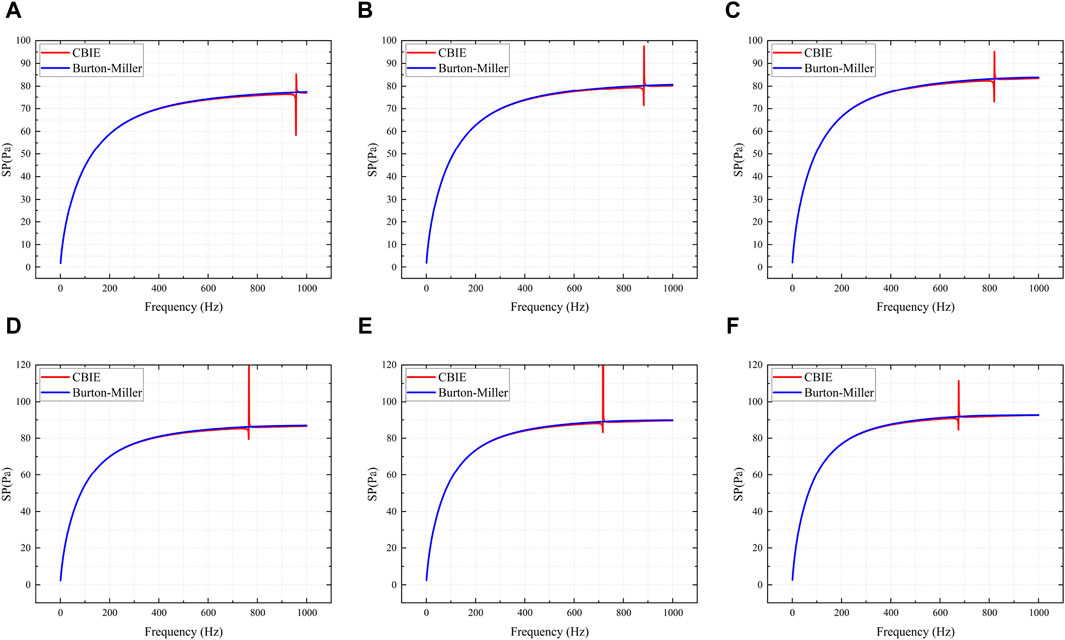
Figure 3. Sound pressure obtained using CBIE and Burton-Miller for different radius. (A): r0 = 0.60 m, (B): r0 = 0.65 m, (C): r0 = 0.70 m, (D): r0 = 0.75 m, (E): r0 = 0.80 m, (F): r0 = 0.85 m.
Several conclusions can be inferred from Figure 3. As the radius of the pipe increases, the sound pressure also increases. The results obtained using the conventional boundary element method (CBEM) and Burton-Miller exhibit a high degree of similarity. However, when the radius exceeds
The sound pressure results obtained using BEM based on Taylor expansion are presented in Figure 4. A frequency step of 1 Hz is utilized, and the width of each frequency band is set to
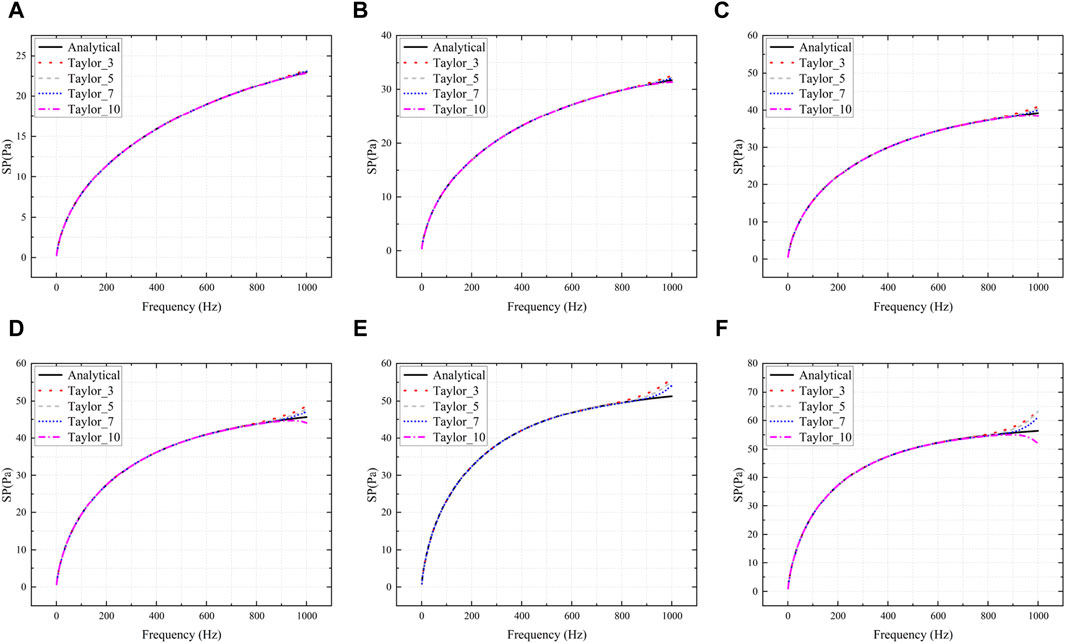
Figure 4. Sound pressure calculated with different number of Taylor expansion terms. (A): r0 = 0.10 m, (B): r0 = 0.15 m, (C): r0 = 0.20 m, (D): r0 = 0.25 m, (E): r0 = 0.30 m, (F): r0 = 0.35 m.
It becomes evident that sound pressure values exhibit variations across different frequency bands, as shown in Figure 4. Furthermore, within the same frequency band, the sound pressure values determined through the numerical method closely align with those obtained analytically. However, as the distance from the expansion point increases, the error also increases. Among the considered Taylor expansion terms,
As depicted in Figure 4, the numerical results exhibit general concordance with the analytical solution across various numbers of expansion terms. However, notable discrepancies arise at the extremities of the frequency band range. The observed agreement between the numerical and analytical solutions is primarily evident in the central region of the frequency spectrum. The discrepancies observed at the lower and upper ends of the frequency range primarily arise from the positioning of the fixed frequency expansion point at the midpoint of the range. As a result, as the distance from this fixed expansion point increases, the accuracy of the numerical results tends to deteriorate. To mitigate these deviations, the original frequency range of [1, 1,000] Hz has been subdivided into four distinct subranges: [1, 250] Hz, [250, 500] Hz, [500, 750] Hz, and [750, 1,000] Hz. Subsequent numerical simulations have been conducted within these refined subranges. As an illustrative example, consider the case where
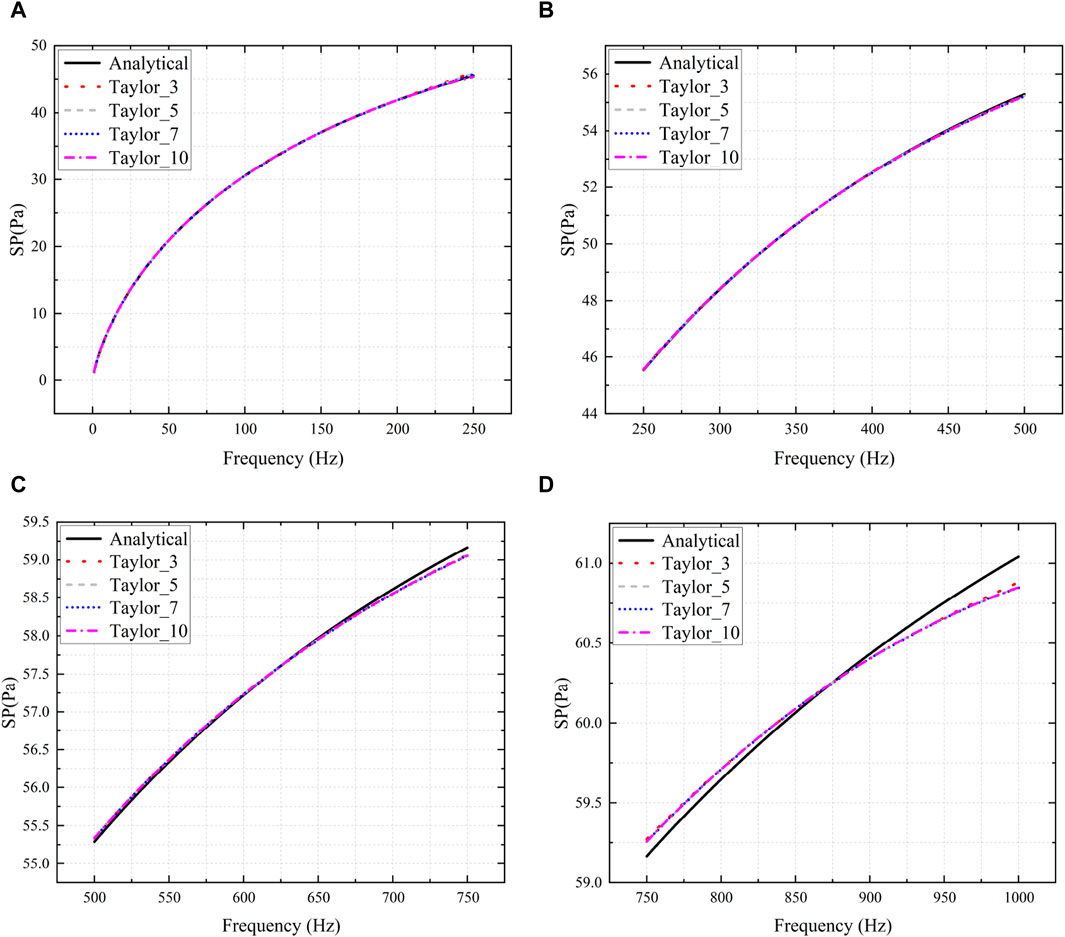
Figure 5. Sound pressure calculated with different number of Taylor expansion terms.
The
Due to the continuous development of artificial intelligence, bionic technology is becoming more and more sophisticated. Now we are working on the fins of an underwater bionic fish, which we can simplify into a wing-shaped model. For the airfoil model shown in Figure 7, CBIE and Taylor expansion is used to calculate the sound pressure at (2, 0) in the four frequency bands of [1–1,000] Hz, [1,000–2,000] Hz, [2,000–3,000] Hz and [3,000–4,000] Hz, respectively, as shown in Figure 8. It can be seen that the analytical solution bears a substantial resemblance to the solution derived using Taylor expansion across various frequency bands. Notably, the outcome at the Taylor expansion point precisely aligns with the analytical solution. However, as one moves further away from the expansion point, the divergence between the two solutions gradually increases.
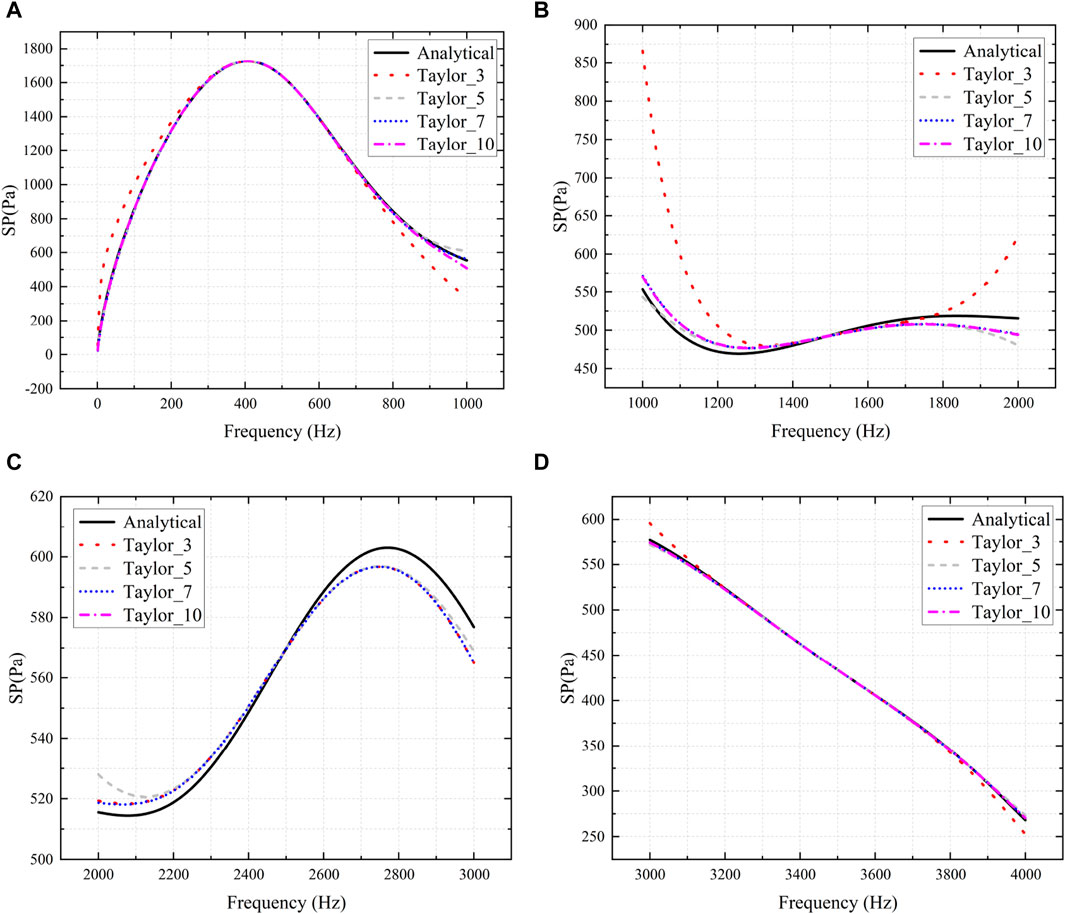
Figure 8. Sound pressure obtained using the analytical method and the boundary element method based on Taylor expansion. (A): 1–1000 Hz, (B): 1000–2000 Hz, (C): 2000–3000 Hz, (D): 3000–4000 Hz.
To minimize the errors arising from the calculation, we will continue to subdivide [1–1,000] Hz into [1–250] Hz, [250–500] Hz, [500–750] Hz and [750–1,000] Hz, as shown in Figure 9. It can be seen that as the frequency band decreases, the solution based on Taylor expansion results in smaller errors. Therefore, we can conclude that the smaller the frequency band of the expansion, the closer the result of the Taylor expansion is to the real solution.
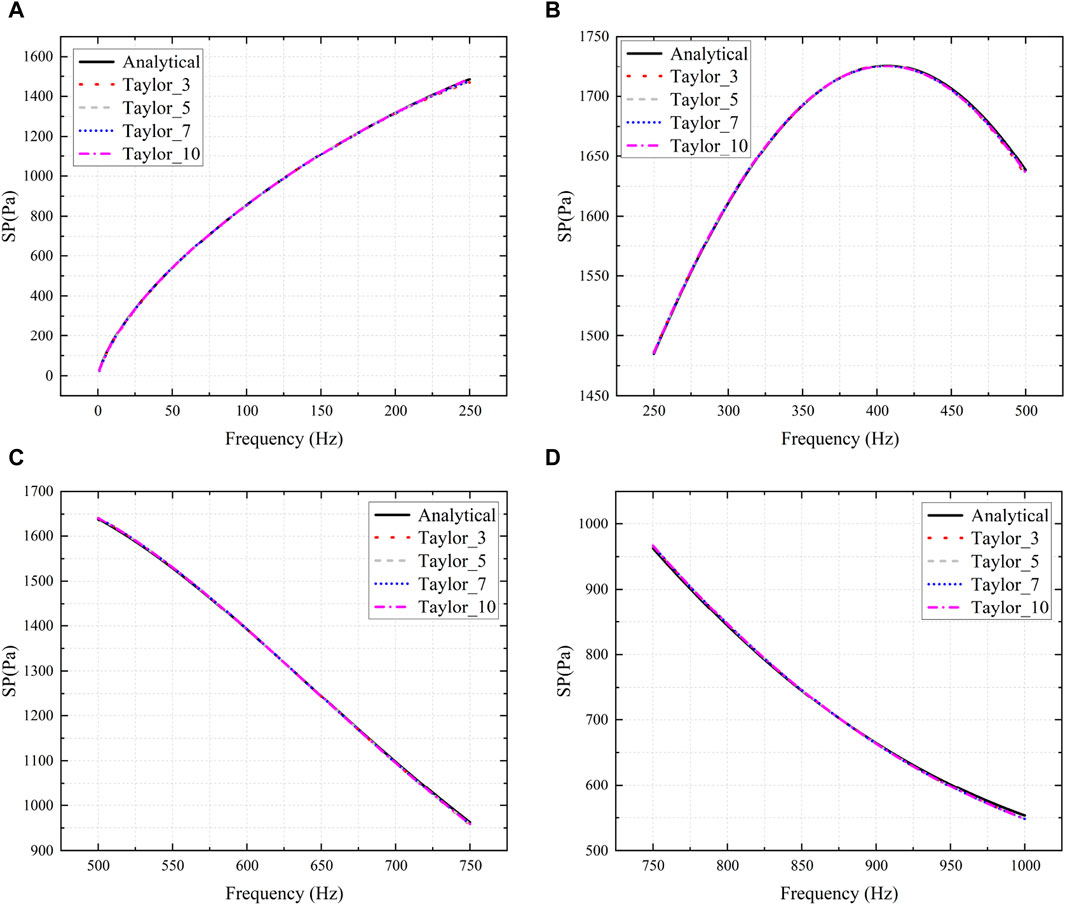
Figure 9. Sound pressure obtained using analytical solution and Taylor expansion methods. (A): 1–250 Hz, (B): 250–500 Hz, (C): 500–750 Hz, (D): 750–1000 Hz.
The acoustic analysis of a half-Y-shaped sound barrier (Figure 10) is carried out in this subsection. Figure 11 gives the real part, the imaginary part and the amplitude of the sound pressure at point (16, 2). It can be seen that the sound pressure exhibits variation among the different expansion terms, particularly at the extremities of the frequency range. Consequently, in this subsection, an adaptive band segmentation technique is employed to partition the frequency range of [1, 200] Hz into two sub-intervals. The sound pressure results of the two sub-intervals are shown in Figure 12. It can be seen that the results obtained demonstrate a remarkable consistency, irrespective of the number of expansion terms employed. This result just validates the effectiveness of the proposed adaptive band segmentation technique.

Figure 11. Sound pressure results at (16, 2) for the half-Y-shaped model. (A): the real part, (B): the imaginary part, (C): the amplitude.
Figure 13 compares the CPU time spent on the proposed method and CBEM for two different frequency settings. It can be seen that the proposed method exhibits a substantial decrease in CPU time when compared to CBEM. Although the CPU time escalates with an augmentation in the number of Taylor expansion terms, using Taylor expansion will still greatly reduce the CPU time used for wideband computation using the proposed method.
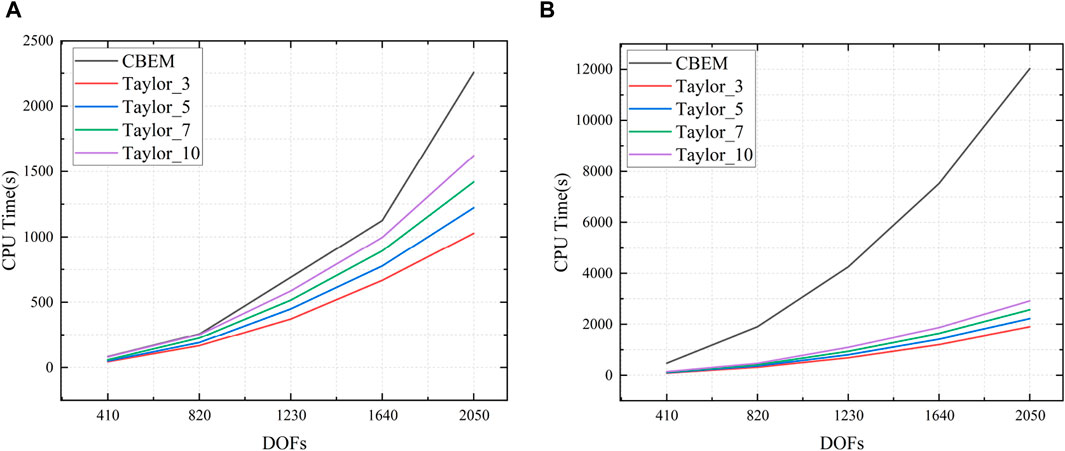
Figure 13. CPU time spent on numerical simulations using CBEM and Taylor expansion. (A): Frequency band (1, 100) Hz, step 1 Hz. (B): Frequency band (1, 100) Hz, step 0.1 Hz.
This paper focuses on the two-dimensional acoustic problems. The Burton-Miller method is used to solve the fictitious eigenfrequency problem. The Taylor expansion method is used to solve the problem of frequency dependence and low computational efficiency in wideband analysis, showing the time requirement advantage of the Taylor expansion over CBEM. The error in Taylor expansion-based analysis is reduced by narrowing the frequency bands. The validity of the adaptive frequency band segmentation technique is verified by comparing the sound pressure of each expansion term. The necessity of Taylor expansion is illustrated by comparing the CPU time. In practical engineering applications, the circular and airfoil arithmetic examples in this paper provide a reference for studying the noise problem of underwater vehicles. The Burton-Miller method and the Taylor expansion technique introduced in the paper are also able to be applied to other areas of acoustics.
The original contributions presented in the study are included in the article/supplementary material, further inquiries can be directed to the corresponding author.
YY: Conceptualization, Funding acquisition, Investigation, Methodology, Project administration, Writing–original draft. GL: Conceptualization, Data curation, Visualization, Writing–original draft. SY: Validation, Writing–original draft. YX: Formal Analysis, Resources, Software, Supervision, Writing–review and editing.
The authors declare that financial support was received for the research, authorship, and/or publication of this article. Sponsored by the Henan Provincial Key R&D and Promotion Project under Grant No. 232102220033, the Henan Province science and technology research project under Grant No. 242102321031, the Youth Backbone Teacher Training Program of Henan Province under Grant No. 2019GGJS232, the Zhumadian 2023 Major Science and Technology Special Project under Grant No. ZMDSZDZX2023002, the Natural Science Foundation of Henan under Grant No. 222300420498, and the Postgraduate Education Reform and Quality Improvement Project of Henan Province under Grant No. YJS2023JD52.
The authors declare that the research was conducted in the absence of any commercial or financial relationships that could be construed as a potential conflict of interest.
All claims expressed in this article are solely those of the authors and do not necessarily represent those of their affiliated organizations, or those of the publisher, the editors and the reviewers. Any product that may be evaluated in this article, or claim that may be made by its manufacturer, is not guaranteed or endorsed by the publisher.
1. Lian H, Chen L, Lin X, Zhao W, Bordas SPA, Zhou M. Noise pollution reduction through a novel optimization procedure in passive control methods. Comput Model Eng Sci (2022) 131:1–18. doi:10.32604/cmes.2022.019705
2. Ding C, Tamma K, Cui X, Ding Y, Li G, Bordas S. An nth high order perturbation-based stochastic isogeometric method and implementation for quantifying geometric uncertainty in shell structures. Adv Eng Softw (2020) 148:102866. doi:10.1016/j.advengsoft.2020.102866
3. Marburg S. Developments in structural-acoustic optimization for passive noise control. Arch Comput Methods Eng (2002) 9:291–370. doi:10.1007/BF03041465
4. Xu Y, Li H, Chen L, Zhao J, Zhang X. Monte Carlo based isogeometric stochastic finite element method for uncertainty quantization in vibration analysis of piezoelectric materials. Mathematics (2022) 10:1840. doi:10.3390/math10111840
5. Chen L, Cheng R, Li S, Lian H, Zheng C, Bordas SP. A sample-efficient deep learning method for multivariate uncertainty qualification of acoustic–vibration interaction problems. Comput Methods Appl Mech Eng (2022) 393:114784. doi:10.1016/j.cma.2022.114784
6. Zhao W, Chen L, Chen H, Marburg S. Topology optimization of exterior acoustic-structure interaction systems using the coupled fem-bem method. Int J Numer Methods Eng (2019) 119:404–31. doi:10.1002/nme.6055
7. Zhao W, Chen L, Chen H, Marburg S. An effective approach for topological design to the acoustic-structure interaction systems with infinite acoustic domain. Struct Multidisciplinary Optimization (2020) 62:1253–73. doi:10.1007/s00158-020-02550-2
8. Venås JV, Kvamsdal T. Isogeometric boundary element method for acoustic scattering by a submarine. Comput Methods Appl Mech Eng (2020) 359:112670. doi:10.1016/j.cma.2019.112670
9. Shen X, Du C, Jiang S, Zhang P, Chen L. Multivariate uncertainty analysis of fracture problems through model order reduction accelerated sbfem. Appl Math Model (2024) 125:218–40. doi:10.1016/j.apm.2023.08.040
10. Zhang G, Qu Y, Gao XL, Jin F. A transversely isotropic magneto-electro-elastic timoshenko beam model incorporating microstructure and foundation effects. Mech Mater (2020) 149:103412. doi:10.1016/j.mechmat.2020.103412
11. Zhang GY, Guo ZW, Qu YL, Gao XL, Jin F. A new model for thermal buckling of an anisotropic elastic composite beam incorporating piezoelectric, flexoelectric and semiconducting effects. Acta Mechanica (2022) 233:1719–38. doi:10.1007/s00707-022-03186-7
12. Shen X, Du C, Jiang S, Sun L, Chen L. Enhancing deep neural networks for multivariate uncertainty analysis of cracked structures by pod-rbf. Theor Appl Fracture Mech (2023) 125:103925. doi:10.1016/j.tafmec.2023.103925
13. Coox L, Atak O, Vandepitte D, Desmet W. An isogeometric indirect boundary element method for solving acoustic problems in open-boundary domains. Comput Methods Appl Mech Eng (2017) 316:186–208. Special Issue on Isogeometric Analysis: Progress and Challenges. doi:10.1016/j.cma.2016.05.039
14. Chen L, Lian H, Xu Y, Li S, Liu Z, Atroshchenko E, et al. Generalized isogeometric boundary element method for uncertainty analysis of time-harmonic wave propagation in infinite domains. Appl Math Model (2023) 114:360–78. doi:10.1016/j.apm.2022.09.030
15. Zhang J, Zhou J, Wang S, Wang H, Lu F. Research on dynamic characteristics and radiation noise of a helicopter main reducer based on finite element and boundary element method. J Mech Sci Technol (2023) 37:4489–505. doi:10.1007/s12206-023-0807-9
16. Zhang S, Yu B, Chen L. Non-iterative reconstruction of time-domain sound pressure and rapid prediction of large-scale sound field based on ig-drbem and pod-rbf. J Sound Vibration (2024) 573:118226. doi:10.1016/j.jsv.2023.118226
17. Chen L, Chen H, Zheng C, Marburg S. Structural–acoustic sensitivity analysis of radiated sound power using a finite element/discontinuous fast multipole boundary element scheme. Int J Numer Methods Fluids (2016) 82:858–78. doi:10.1002/fld.4244
18. Qu YL, Guo ZW, Zhang GY, Gao XL, Jin F. A new model for circular cylindrical Kirchhoff–love shells incorporating microstructure and flexoelectric effects. J Appl Mech (2022) 89:121010. doi:10.1115/1.4055658
19. Liu Z, Bian PL, Qu Y, Huang W, Chen L, Chen J, et al. A galerkin approach for analysing coupling effects in the piezoelectric semiconducting beams. Eur J Mech - A/Solids (2024) 103:105145. doi:10.1016/j.euromechsol.2023.105145
20. Marburg S The burton and miller method: unlocking another mystery of its coupling parameter. J Comput Acoust (2016) 24:1550016. doi:10.1142/s0218396x15500162
21. Lian H, Kerfriden P, Bordas S. Shape optimization directly from cad: an isogeometric boundary element approach using t-splines. Comput Methods Appl Mech Eng (2017) 317:1–41. doi:10.1016/j.cma.2016.11.012
22. Chen L, Marburg S, Zhao W, Liu C, Chen H. Implementation of isogeometric fast multipole boundary element methods for 2d half-space acoustic scattering problems with absorbing boundary condition. J Theor Comput Acoust (2018) 27:1850024. doi:10.1142/S259172851850024X
23. Chen L, Lu C, Lian H, Liu Z, Zhao W, Li S, et al. Acoustic topology optimization of sound absorbing materials directly from subdivision surfaces with isogeometric boundary element methods. Comput Methods Appl Mech Eng (2020) 362:112806. doi:10.1016/j.cma.2019.112806
24. Dölz J, Kurz S, Schöps S, Wolf F. Isogeometric boundary elements in electromagnetism: rigorous analysis, fast methods, and examples. SIAM J Scientific Comput (2019) 41:B983–B1010. doi:10.1137/18M1227251
25. Sumbatyan M, Martynova T, Musatova N. Boundary element methods in diffraction of a point-source acoustic wave by a rigid infinite wedge. Eng Anal Boundary Elem (2021) 125:157–67. doi:10.1016/j.enganabound.2021.01.017
26. Kurz S, Schöps S, Unger G, Wolf F. Solving maxwell’s eigenvalue problem via isogeometric boundary elements and a contour integral method. Math Methods Appl Sci (2021) 44:10790–803. doi:10.1002/mma.7447
27. Cheng S, Wang F, Li PW, Qu W. Singular boundary method for 2d and 3d acoustic design sensitivity analysisimage 1. Comput Maths Appl (2022) 119:371–86. doi:10.1016/j.camwa.2022.06.009
28. Chen L, Li K, Peng X, Lian H, Lin X, Fu Z. Isogeometric boundary element analysis for 2d transient heat conduction problem with radial integration method. CMES-Computer Model Eng Sci (2021) 126:125–46. doi:10.32604/cmes.2021.012821
29. Chen L, Lian H, Liu Z, Gong Y, Zheng S. CJand Bordas. Bi-material topology optimization for fully coupled structural-acoustic systems with isogeometric fem–bem. Eng Anal Boundary Elem (2022) 135:182–95. doi:10.1016/j.enganabound.2021.11.005
30. Chen L, Zhang Y, Lian H, Atroshchenko E, Ding C, Bordas S. Seamless integration of computer-aided geometric modeling and acoustic simulation: isogeometric boundary element methods based on catmull-clark subdivision surfaces. Adv Eng Softw (2020) 149:102879. doi:10.1016/j.advengsoft.2020.102879
31. Chen L, Lian H, Dong H, Yu P, Jiang S, Bordas S. Broadband topology optimization of three-dimensional structural-acoustic interaction with reduced order isogeometric fem/bem. J Comput Phys (2024) 509:113051. doi:10.1016/j.jcp.2024.113051
32. Chen L, Lian H, Liu Z, Chen H, Atroshchenko E, Bordas S. Structural shape optimization of three dimensional acoustic problems with isogeometric boundary element methods. Comput Methods Appl Mech Eng (2019) 355:926–51. doi:10.1016/j.cma.2019.06.012
33. Qu Y, Jin F, Zhang G. Mechanically induced electric and magnetic fields in the bending and symmetric-shear deformations of a microstructure-dependent fg-mee composite beam. Compos Structures (2021) 278:114554. doi:10.1016/j.compstruct.2021.114554
34. Cao G, Yu B, Chen L, Yao W. Isogeometric dual reciprocity bem for solving non-fourier transient heat transfer problems in fgms with uncertainty analysis. Int J Heat Mass Transfer (2023) 203:123783. doi:10.1016/j.ijheatmasstransfer.2022.123783
35. Qu Y, Pan E, Zhu F, Jin F, Roy AK. Modeling thermoelectric effects in piezoelectric semiconductors: new fully coupled mechanisms for mechanically manipulated heat flux and refrigeration. Int J Eng Sci (2023) 182:103775. doi:10.1016/j.ijengsci.2022.103775
36. Zheng CJ, Bi CX, Zhang C, Zhang YB, Chen HB. Fictitious eigenfrequencies in the bem for interior acoustic problems. Eng Anal Boundary Elem (2019) 104:170–82. doi:10.1016/j.enganabound.2019.03.042
37. Toshimitsu R, Isakari H. A burton–miller-type boundary element method based on a hybrid integral representation and its application to cavity scattering. Eng Anal Boundary Elem (2024) 158:303–12. doi:10.1016/j.enganabound.2023.11.003
38. Fu ZJ, Chen W, Gu Y. Burton–miller-type singular boundary method for acoustic radiation and scattering. J Sound Vibration (2014) 333:3776–93. doi:10.1016/j.jsv.2014.04.025
39. Zheng CJ, Chen HB, Gao HF, Du L. Is the burton–miller formulation really free of fictitious eigenfrequencies? Eng Anal Boundary Elem (2015) 59:43–51. doi:10.1016/j.enganabound.2015.04.014
40. Zhang J, Lin W, Shu X, Zhong Y. A dual interpolation boundary face method for exterior acoustic problems based on the burton–miller formulation. Eng Anal Boundary Elem (2020) 113:219–31. doi:10.1016/j.enganabound.2020.01.005
41. Chen L, Marburg S, Chen H, Zhang H, Gao H. An adjoint operator approach for sensitivity analysis of radiated sound power in fully coupled structural-acoustic systems. J Comput Acoust (2017) 25:1750003. doi:10.1142/S0218396X17500035
42. Wu Y, Dong C, Yang H. Isogeometric indirect boundary element method for solving the 3d acoustic problems. J Comput Appl Maths (2020) 363:273–99. doi:10.1016/j.cam.2019.06.013
43. Chen L, Liu C, Zhao W, Liu L. An isogeometric approach of two dimensional acoustic design sensitivity analysis and topology optimization analysis for absorbing material distribution. Comput Methods Appl Mech Eng (2018) 336:507–32. doi:10.1016/j.cma.2018.03.025
44. Liu X, Xu J. A low-frequency fast multipole boundary element method for acoustic problems in a subsonic uniform flow. Eng Anal Boundary Elem (2024) 162:102–16. doi:10.1016/j.enganabound.2024.01.026
45. Liu B, Wang Q, Feng Y, Zhang ZS, Huang Q, Tian W, et al. The fast multipole method–accelerated line integration boundary element method for 3d heat conduction analysis with heat source. Eng Computations (2023) 40:1676–97. doi:10.1108/ec-03-2022-0157
46. Li Y, Atak O, Desmet W. Novel and efficient implementation of multi-level fast multipole indirect bem for industrial helmholtz problems. Eng Anal Boundary Elem (2024) 159:150–63. doi:10.1016/j.enganabound.2023.11.027
47. Zhang G, Gao X, Wang S, Hong J. Bandgap and its defect band analysis of flexoelectric effect in phononic crystal plates. Eur J Mech - A/Solids (2024) 104:105192. doi:10.1016/j.euromechsol.2023.105192
48. Zhang G, Gao XL. A non-classical model for first-ordershear deformation circular cylindrical thin shells incorporating microstructure and surface energy effects. Maths Mech Sol (2021) 26:1294–319. doi:10.1177/1081286520978488
49. Jin Q, Thompson DJ, Lurcock DE, Toward MG, Ntotsios E. A 2.5d finite element and boundary element model for the ground vibration from trains in tunnels and validation using measurement data. J Sound Vibration (2018) 422:373–89. doi:10.1016/j.jsv.2018.02.019
50. Li Z, Gao Z, Liu Y. Enriched constant elements in the boundary element method for solving 2d acoustic problems at higher frequencies. Comput Model Eng Sci (2024) 138:2159–75. doi:10.32604/cmes.2023.030920
51. Lei J, Shao C, Zhang C. Frequency-domain fundamental solutions and boundary element method for consistent couple stress elastodynamic problems. Int J Numer Methods Eng (2023) 124:4992–5019. doi:10.1002/nme.7335
52. Li Y, Atak O, Jonckheere S, Desmet W. Accelerating boundary element methods in wideband frequency sweep analysis by matrix-free model order reduction. J Sound Vibration (2022) 541:117323. doi:10.1016/j.jsv.2022.117323
53. Chen L, Lu C, Zhao W, Chen H, Zheng C. Subdivision surfaces—boundary element accelerated by fast multipole for the structural acoustic problem. J Theor Comput Acoust (2020) 28:2050011. doi:10.1142/s2591728520500115
54. Wang Z, Zhao Z, Liu Z, Huang Q. A method for multi-frequency calculation of boundary integral equation in acoustics based on series expansion. Appl Acoust (2009) 70:459–68. doi:10.1016/j.apacoust.2008.05.005
55. Ramzan M, Ahmad MO, Bashir MN, Asghar A, Shehzad SA. Development of numerical tools using boundary element method based on taylor series for nonlinear analysis. Mod Phys Lett B (2023) 37. doi:10.1142/s0217984923500501
56. Han Z, Pan W, Cheng C, Hu Z, Niu Z. A semi-analytical treatment for nearly singular integrals arising in the isogeometric boundary element method-based solutions of 3d potential problems. Comput Methods Appl Mech Eng (2022) 398:115179. doi:10.1016/j.cma.2022.115179
57. Riaz M, Hashmi MR, Pamucar D, Chu Y. Spherical linear diophantine fuzzy sets with modeling uncertainties in mcdm. Comput Model Eng Sci (2021) 126:1125–64. doi:10.32604/cmes.2021.013699
58. Chen L, Lian H, Natarajan S, Zhao W, Chen X, Bordas S. Multi-frequency acoustic topology optimization of sound-absorption materials with isogeometric boundary element methods accelerated by frequency-decoupling and model order reduction techniques. Comput Methods Appl Mech Eng (2022) 395:114997. doi:10.1016/j.cma.2022.114997
59. Chen L, Wang Z, Lian H, Ma Y, Meng Z, Li P, et al. Reduced order isogeometric boundary element methods for cad-integrated shape optimization in electromagnetic scattering. Comput Methods Appl Mech Eng (2024) 419:116654. doi:10.1016/j.cma.2023.116654
60. Liu Y. On the bem for acoustic wave problems. Eng Anal Boundary Elem (2019) 107:53–62. doi:10.1016/j.enganabound.2019.07.002
61. Zheng YT, Liu Y, Gao XW, Yang Y, Peng HF. Improved hole and tube elements in bem for elasticity problems. Eng Anal Boundary Elem (2024) 159:17–35. doi:10.1016/j.enganabound.2023.11.021
62. Qu Y, Zhou Z, Chen L, Lian H, Li X, Hu Z, et al. Uncertainty quantification of vibro-acoustic coupling problems for robotic manta ray models based on deep learning. Ocean Eng (2024) 299:117388. doi:10.1016/j.oceaneng.2024.117388
63. Dölz J, Harbrecht H, Kurz S, Schöps S, Wolf F. A fast isogeometric bem for the three dimensional laplace- and helmholtz problems. Comput Methods Appl Mech Eng (2018) 330:83–101. doi:10.1016/j.cma.2017.10.020
Keywords: boundary element method, Burton-Miller method, Taylor expansion, singular integral, Helmholtz equation
Citation: Yang Y, Lei G, Yang S and Xu Y (2024) Two-dimensional acoustic analysis using Taylor expansion-based boundary element method. Front. Phys. 12:1420874. doi: 10.3389/fphy.2024.1420874
Received: 21 April 2024; Accepted: 10 June 2024;
Published: 15 July 2024.
Edited by:
Pei Li, University of Southern Denmark, DenmarkReviewed by:
Kui Liu, Harbin Institute of Technology, ChinaCopyright © 2024 Yang, Lei, Yang and Xu. This is an open-access article distributed under the terms of the Creative Commons Attribution License (CC BY). The use, distribution or reproduction in other forums is permitted, provided the original author(s) and the copyright owner(s) are credited and that the original publication in this journal is cited, in accordance with accepted academic practice. No use, distribution or reproduction is permitted which does not comply with these terms.
*Correspondence: Yanming Xu, eHV5YW5taW5nQHVzdGMuZWR1
Disclaimer: All claims expressed in this article are solely those of the authors and do not necessarily represent those of their affiliated organizations, or those of the publisher, the editors and the reviewers. Any product that may be evaluated in this article or claim that may be made by its manufacturer is not guaranteed or endorsed by the publisher.
Research integrity at Frontiers

Learn more about the work of our research integrity team to safeguard the quality of each article we publish.